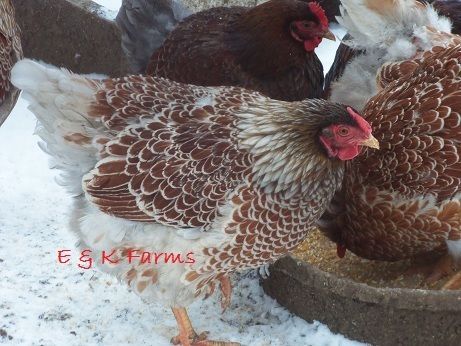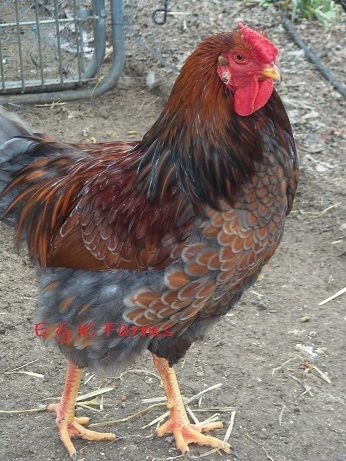- Thread starter
- #891
Navigation
Install the app
How to install the app on iOS
Follow along with the video below to see how to install our site as a web app on your home screen.
Note: This feature may not be available in some browsers.
More options
You are using an out of date browser. It may not display this or other websites correctly.
You should upgrade or use an alternative browser.
You should upgrade or use an alternative browser.
Here we go again - I'm hatching more goslings!!
- Thread starter Iain Utah
- Start date
I have a question ..... what the heck do I do with chicken eggs???? when do I turn off the urner? Do I remover the eggs and if I do ... do I stand them up or lay them down.? can I pull some of them 2 days early as trying to make sure I have some hatch while grandkids are here.

Okay, Sue chickens are my specialty: They go off the turners 3 days before they hatch. You can take them off the turners and lay them on the floor of the bator. Some ppl use the egg carton method I have tried both ways. Clean up is easier with the egg cartons but sometimes they pip on the wrong end and die I have found out. Chickens are way easy compared to the geese I'm thinking..

Nice pics! Looks really close to internally pipping! Listen carefully for clicking sounds... that is the baby learning how to breathe which is officially the completion of the internal pipping process.
Wait, isn't it already internally pipped? Or is what I see just the baby pressing against the membrane? I listened for clicking this morning but didn't hear anything.
- Thread starter
- #895
From what I can tell in your picture, it has ALMOST internally pipped, but not quite yet.
This is taken directly from Pete's hatching guide in the sticky section.
Within another 12 -24 hours of dip down of the air cell there will be shadows become visible within the air cell. These start at the back of the air cell and over a further 12-24 hours gradually extend down the sides and finally along the front of the air cell. On candling there is often movement visible of the shadows. This change is due to the chick gradually moving into its final hatching position. It gradually draws its head up from a position facing its tail and upwards towards the air cell. When viewed from the air cell end of the egg the chicks head is turned towards the right and under its right wing. With the head and beak lying adjacent to the air cell membrane the chick is ready for internal pipping. As the chick is almost fully mature the chorio-allantoic membrane is unable to fully meet the chicks respiration requirements. Oxygen saturation levels fall slightly and Carbon Dioxide levels begin to rise. Often this change in the failing chorio-allantoic membrane can be seen on candling as previously visible red blood vessels appear to take on a darker red colour. The change in blood gas levels is thought to provoke involuntary muscle contractions which have a two-fold effect. The large hatching muscle located on the chicks neck begins to contract with force and results in the chicks bill piercing the inner membrane of the air cell. This is further helped by a tiny sharp harder area on the tip of the upper bill (the egg tooth). With a hole in the air cell membrane the chick is finally in a position to commence breathing using its lungs. Starting with occasional breaths a regular pattern of pulmonary respiration soon becomes established. Internal pipping has now been achieved and a major physiological change has occurred. Internal pipping can be verified in two ways; often the shadows visible in the air cell on candling appear to pule rhythmically and if the blunt end of the egg is held to the ear a faint click clickclick sound can be heard.


Graphics showing the appearence on candling of the start of 'Shadowing' from the side and front view of the egg.



Graphics & Picture showing the appearance on candling of the progress of 'Shadowing' and 'Internal Pipping' viewed from the side and front of the egg.
This is taken directly from Pete's hatching guide in the sticky section.
Within another 12 -24 hours of dip down of the air cell there will be shadows become visible within the air cell. These start at the back of the air cell and over a further 12-24 hours gradually extend down the sides and finally along the front of the air cell. On candling there is often movement visible of the shadows. This change is due to the chick gradually moving into its final hatching position. It gradually draws its head up from a position facing its tail and upwards towards the air cell. When viewed from the air cell end of the egg the chicks head is turned towards the right and under its right wing. With the head and beak lying adjacent to the air cell membrane the chick is ready for internal pipping. As the chick is almost fully mature the chorio-allantoic membrane is unable to fully meet the chicks respiration requirements. Oxygen saturation levels fall slightly and Carbon Dioxide levels begin to rise. Often this change in the failing chorio-allantoic membrane can be seen on candling as previously visible red blood vessels appear to take on a darker red colour. The change in blood gas levels is thought to provoke involuntary muscle contractions which have a two-fold effect. The large hatching muscle located on the chicks neck begins to contract with force and results in the chicks bill piercing the inner membrane of the air cell. This is further helped by a tiny sharp harder area on the tip of the upper bill (the egg tooth). With a hole in the air cell membrane the chick is finally in a position to commence breathing using its lungs. Starting with occasional breaths a regular pattern of pulmonary respiration soon becomes established. Internal pipping has now been achieved and a major physiological change has occurred. Internal pipping can be verified in two ways; often the shadows visible in the air cell on candling appear to pule rhythmically and if the blunt end of the egg is held to the ear a faint click clickclick sound can be heard.
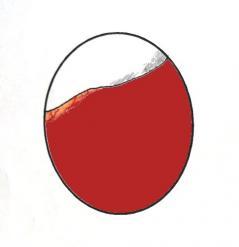
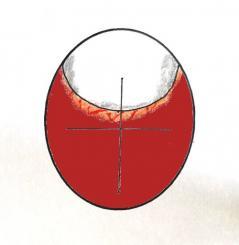
Graphics showing the appearence on candling of the start of 'Shadowing' from the side and front view of the egg.

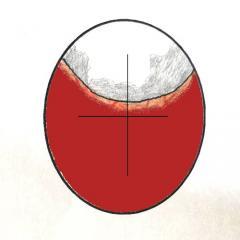
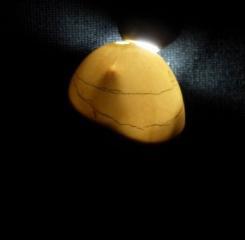
Graphics & Picture showing the appearance on candling of the progress of 'Shadowing' and 'Internal Pipping' viewed from the side and front of the egg.
- Thread starter
- #896
Erin, today is day 21 for your toulouse baby. I candled, weighed and marked air cell line. I saw nice movement and veining inside, a perfect air cell, and it has lost 23 grams (set at 197g), so it is on perfect target for 14-15% weight loss.


From what I can tell in your picture, it has ALMOST internally pipped, but not quite yet.
This is taken directly from Pete's hatching guide in the sticky section.
Within another 12 -24 hours of dip down of the air cell there will be shadows become visible within the air cell. These start at the back of the air cell and over a further 12-24 hours gradually extend down the sides and finally along the front of the air cell. On candling there is often movement visible of the shadows. This change is due to the chick gradually moving into its final hatching position. It gradually draws its head up from a position facing its tail and upwards towards the air cell. When viewed from the air cell end of the egg the chicks head is turned towards the right and under its right wing. With the head and beak lying adjacent to the air cell membrane the chick is ready for internal pipping. As the chick is almost fully mature the chorio-allantoic membrane is unable to fully meet the chicks respiration requirements. Oxygen saturation levels fall slightly and Carbon Dioxide levels begin to rise. Often this change in the failing chorio-allantoic membrane can be seen on candling as previously visible red blood vessels appear to take on a darker red colour. The change in blood gas levels is thought to provoke involuntary muscle contractions which have a two-fold effect. The large hatching muscle located on the chicks neck begins to contract with force and results in the chicks bill piercing the inner membrane of the air cell. This is further helped by a tiny sharp harder area on the tip of the upper bill (the egg tooth). With a hole in the air cell membrane the chick is finally in a position to commence breathing using its lungs. Starting with occasional breaths a regular pattern of pulmonary respiration soon becomes established. Internal pipping has now been achieved and a major physiological change has occurred. Internal pipping can be verified in two ways; often the shadows visible in the air cell on candling appear to pule rhythmically and if the blunt end of the egg is held to the ear a faint click clickclick sound can be heard.


Graphics showing the appearence on candling of the start of 'Shadowing' from the side and front view of the egg.



Graphics & Picture showing the appearance on candling of the progress of 'Shadowing' and 'Internal Pipping' viewed from the side and front of the egg.
Ok. Well ill keep watching it then! In your experience how long does it normally take to hatch from this point?
- Thread starter
- #898
My africans internally pipped on day 28, externally pipped on day 29, and hatched on day 30. My toulouse internally pipped on day 29, externally pipped on day 30 and hatched on day 31.
Ok, thanks. So today is day 27. I guess I'll just have to wait and see...lol
Marty, blue laced red Wyandottes are a very sweet round chicken. They lay good sized brown/tan eggs and seem to be good in the cold and the heat (we have two hens here). So far the black copper Mara s are handling our heat well too after a year and half here. I know they also do well in cold, but need their combs protected from frost bit.
Careful with the BCM stock, many have egg color defects and major comb defects, wing splits going on. Comb issues that are most common can be springs, carnation and thumb print. I can have our son tell you more if you want to know more as the BCM is his flock and he has studied them for a year and uses them as part of his hatching science live animal experiment for school.
Came home to both Sebbie babies externally pipped, and one starting to zip. More babies and one appears dark billed so it won't be white!
Kawonu......Thank you for the box today, nice surprise to come home to.
Careful with the BCM stock, many have egg color defects and major comb defects, wing splits going on. Comb issues that are most common can be springs, carnation and thumb print. I can have our son tell you more if you want to know more as the BCM is his flock and he has studied them for a year and uses them as part of his hatching science live animal experiment for school.
Came home to both Sebbie babies externally pipped, and one starting to zip. More babies and one appears dark billed so it won't be white!
Kawonu......Thank you for the box today, nice surprise to come home to.
Similar threads
- Replies
- 1
- Views
- 734
New posts New threads Active threads
-
Latest threads
-
Ground predator? Hubbby saw a rat the size of a kitten.
- Started by CabritaChicks
- Replies: 0
-
Coughing hen, no swollen eyes or runny nose
- Started by tomo0003
- Replies: 0
-
Are there any Filipinos here? If so I DESPERATELY need your help
- Started by ilikeeggyolks
- Replies: 1
-
-
-
Threads with more replies in the last 15 days
-
-
Ended BYC Poultry Caption Contest 11-07-25 Pic by kattabelly
- Started by TwoCrows
- Replies: 53
-
-
UPDATED serious flystrike
- Started by anomala
- Replies: 52
-
-
×



